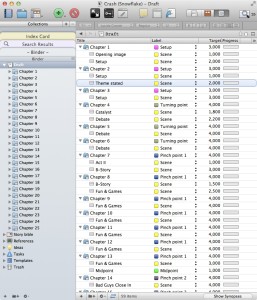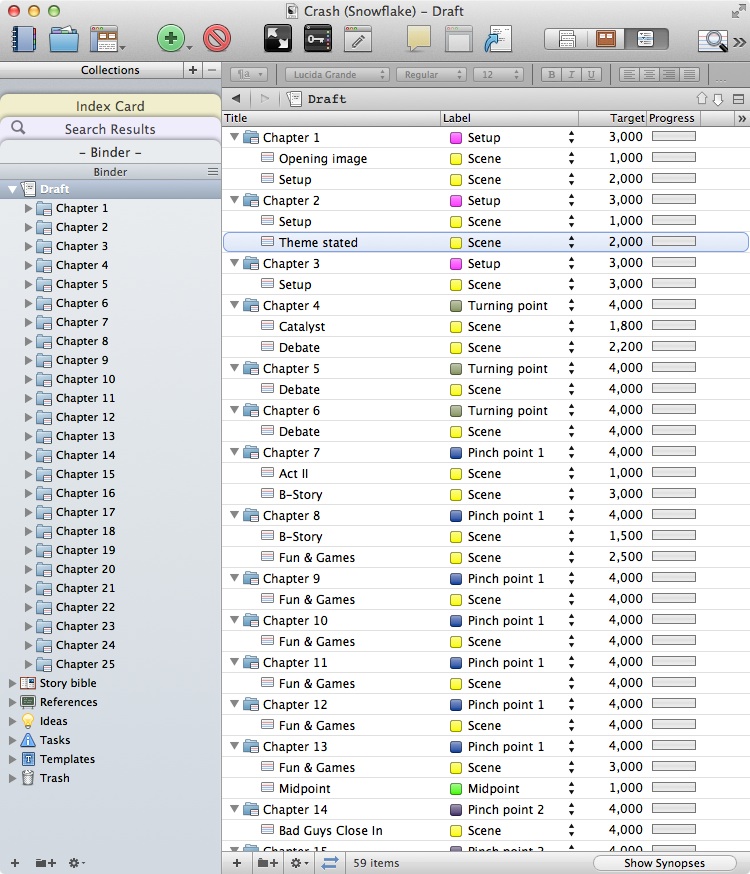About the same time I revisted the BS2, Jami Gold posted an excellent article about using beat sheets with Scrivener. What I liked most about the article was the idea of using the target word count for individual chapters and scenes to lay out the beats.
I don’t know about you, but when it comes to word counts, I find big numbers like 100k pretty intimidating. One of the beauties of the beat sheet is that it breaks down these numbers into manageable chunks. For a 100k-word novel, however, some of those chunks are still 25k words, so I took the idea one step further, with Scrivener.
Before we get started
I’m assuming that you have used, or are at least familiar with, beat sheets and how they work. If you’re not, this post may be a little confusing and I recommend reading Jami Gold’s Beat Sheets 101 post, or Blake Snyder’s book Save the Cat.
If you’re familiar with beat sheets but aren’t sure what your word count should be, trying aiming for your genre’s average. If you’re writing an obscure sub-genre or a mashup, try googling “average word count [your genre]”.
Example: average word count space opera
Breaking the beat sheet into chapters
For most, your chapters are going to be shorter than your beats, and using them to break up the larger chunks of the beat sheet is fairly straight-forward. When you set up a new project in Scrivener, instead of creating folders to reflect the individual beats (opening image, turning point, catalyst, etc), create as many chapters as you think will have in your final novel.
How do you decide how many chapters your finished novel might have? Good question. Easy answer. Find a few novels in your genre and count the number of chapters. Come up with an average and that’s how many chapters you should create.
Example: For my space opera novel, I used Elizabeth Moon’s Vatta’s War series, which has roughly 25 chapters per book
After that, the word goal per chapter is even easier, just divide your total word goal by the number of chapters.
Example: In my case it was 100k words / 25 chapters = 4000 words per chapter.
It’s important to remember that the chapters you’re adding now, and their associated word targets, are approximations. Your story will be as long or a short as it needs to be and, in all likelihood, you’ll add and delete chapters as writing progresses. Right now, they’re just there to help you break your story into smaller, more manageable chunks.
TIP: Creating chapters with word targets, the easy way
By default, when you create a new document in Scrivener’s Draft/Manuscript folder (where you’ll do all of your writing), it creates a new file or Scene. You have to preform a few extra steps (or just remember the shortcut) to create folders, and then there are even more steps to assign a word target to each new folder.
Thankfully, there’s an easier way, all you have to do is create a new default subdocument type. Here’s how.
- Create a new folder in the Templates folder, name it ‘Chapter’ or ‘Bob’ or, really, whatever takes your fancy
- Switch the view to Outline (View -> Outline or cmd+3)
- Add the Target column to the outline (View -> Outliner Columns -> Target). If it’s already in your Outline view, it will have a tick next to it
- Enter the word target per chapter in the Target column
- Select the Draft/Manuscript folder
- Change it’s default subdocument type to the folder you just created in Templates (Documents -> Default New Subdocument Type -> [the folder you created]).
That’s it! Now all you have to do is hit cmd+N to create as many chapters as you need.
Assigning chapters and scenes to beats
At this point, you’ll note that the beats don’t fit nicely into chapters; some, like Act II and Midpoint, don’t even have word counts, while Setup overlaps with Opening Image and Theme Stated. The key here, is to be flexible and not get caught up in exact numbers.
If mapping out the beats seems a little daunting; using the Blake Snyder Beat Sheet: 7-point system redux template, try mapping out the stages (using the Stages column) first. Using labels, and the words per beat column, roughly map out the number of chapters in each stage by dividing the total word count for each stage by the number of words per chapter.
Example: Turning point 1 = 13,650 words / 4000 words per chapter = 3.4 chapters
For those awkward numbers with decimal points, try rounding the number up or down to the nearest whole number.
Example:
Turning point 1 (rounded to the nearest whole number) = 3 chapters
Act II Part 1 = 6.825 chapters = 7 chapters (when rounded)
For the next part, you will need to add scenes to your chapters.
As you did with the Stages, go back through the beat sheet and divide the beats into chapters. Take a closer look at the screenshot above, and you will note that I haven’t named my chapters after my beats, I’ve named the scenes within them instead.
Assigning your beats to scenes instead of chapters just makes the whole process easier. For one, some beats, such as Opening Image at 1000 words, are shorter than a chapter, and others, like Theme Stated, don’t have a word count at all (I gave them a default target of 1000 words). The other, longer beats (Debate, B-Story) can be slotted in around these and between chapters and you can vary the word goal of each, as needed.
Example:
- Chapter 12
- Fun & Games (4000 words)
- Chapter 13
- Fun & Games (3000 words)
- Midpoint (1000 words)
- Chapter 14
- Bad Guys Close In (4000 words)
You’ll need to do some more creative thinking, and a little massaging of scenes and chapters, to get the beat sheet to fit just right, but that’s part of the fun.
What’s next?
That all depends on you. If you’re feeling plannery, you can try outlining your chapters and scenes, but if you’re feeling more panster-ish, dive right on in and start writing that 100k-word sucker.



Thanks for the shout out! 🙂 I hope people find it helpful.
You always write such great posts that I’m sure they can’t help but find it helpful 🙂
Aww, thanks! *blush*
Loved this and found it very helpful! Is there any way you can make into a template? ?
Hi Ivana. Unfortunately not. The beat sheet relies on calculations to give you the word counts and Scrivener isn’t set up for that. I’m afraid you have to do this one by hand.